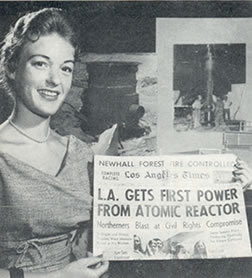A new report on L.A.’s nuked Rocketdyne site finally catches the attention of mainstream media
By Michael Collins
Los Angeles CityBeat/ValleyBeat — October 12, 2006

A new five-year study of Boeing’s monstrously contaminated Santa Susana Field Laboratory (SSFL) sparked unprecedented mainstream print, radio, and television coverage last week. “Study Says Lab Meltdown Caused Cancer” blared an above-the-fold headline in the Los Angeles Times, while the Daily News had as its lead: “Santa Susana meltdown released massive radiation.”
The study shocked even the most veteran SSFL observers, revealing that the now-infamous 1959 meltdown of the lab’s Sodium Reactor Experiment (SRE) most likely caused cancer in 260 to 1,800 people within a 62-mile radius of the east Ventura County lab. The comprehensive probe reported that the SRE disaster released 459 times more of the deadly radionuclides iodine-131 and cesium-137 than Pennsylvania’s Three Mile Island meltdown did in 1979. “A substantial fraction of the volatile radioactive material may well have been released from that accident into the environment and several hundred cancers in the general Los Angeles area are the most likely result,” said co-chair of the panel, Daniel Hirsch, the nuclear watchdog who first exposed the SRE disaster in 1979 and lectures on nuclear policy at UC Santa Cruz. “It could have been as high as several thousand.”
The report also analyzed the potential for contaminated lab soil befouling SSFL groundwater and surface water and thus the pollution’s potential to migrate; of special concern is the toxic rocket fuel additive perchlorate, flowing into the Simi and San Fernando valleys. “So many of the claims made about contamination not being able to move off the [Rocketdyne] property, and therefore not need to be cleaned up, have now been, I think, devastated by these studies,” added Hirsch at an October 5 press conference. “That will lead to added impetus to clean up.”
The $200,000 study, partially funded by the California state legislature, talked about radiation and chemicals oozing off the SSFL site, which has long been hotly contested by parent company Boeing. “We received a summary of the report just yesterday,” read a Boeing statement provided to 89.3 KPCC-FM‘s Patt Morrison program on October 6 (and on which this reporter appeared as a guest) to discuss the panel’s findings. “Our experts have yet to review it. Preliminary assessment is that the study has significant flaws and claims by activists regarding nuclear activities … are baseless, without scientific merit, and a great disservice to our employees and our community.”
Regardless of the criticism, the report’s chillingly detailed analysis of the partial meltdown is impressive. Prior to the mishap, SSFL’s experimental sodium-cooled reactor had been in operation since 1948 and had made nearby Moorpark the first town in the world to get all of its electricity from atomic power. Something went haywire with the SRE in July 1959 with core temperatures skyrocketing and the reactor power level soon doubling every five seconds. What Rocketdyne engineers didn’t know is that a chemical had leaked into the liquid sodium rendering it the consistency of gum and unable to cool the nuclear core. What made that scenario even more nightmarish is that the reactor was housed in an unfortified building unlike the huge concrete containment domes on modern reactors.
“Despite the temperature variations, despite the fact that the reactor was essentially out of control, [Rocketdyne] restarted the reactor shortly thereafter without really doing anything and for the next two weeks the reactor operated with progressively more and more damaged fuel until at the end of July it basically just couldn’t work anymore,” said study consultant David Lochbaum, a nuclear engineer and director of the Nuclear Safety Project for the Washington, D.C.-based Union of Concerned Scientists. “A television camera was lowered into the reactor vessel and showed that instead of where the fuel was, there was space – the fuel had melted and had moved around into other locations.”
Radiation was vented into the atmosphere over a period of weeks. But which way it floated is anybody’s guess, as Boeing refused to supply meteorological data from the time, part of a pattern of secrecy that panelists say hampered the study. “We still don’t have a lot of information that would be important for estimating health impacts from leakages from the site,” said panel co-chair Dr. Steven Wing, associate professor of epidemiology at the University of North Carolina. “For example, Rocketdyne operated a weather station on the site and we, the experts on the panel, were denied the information on which way the wind was blowing during the 1959 accident at the Sodium Reactor Experiment.”
Ventura County Supervisor Linda Parks has asked the state attorney general to force Boeing to release the information.
The SSFL Advisory Panel report can be read at SSFLpanel.org.
27 Years of Award-Winning SSFL/Rocketdyne Reporting
1998 – 2025












Recent Comments